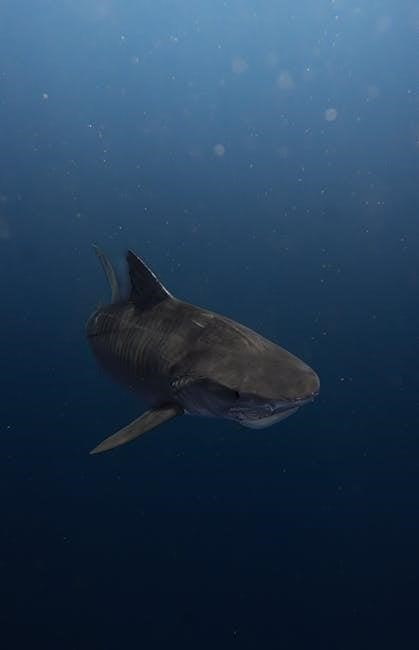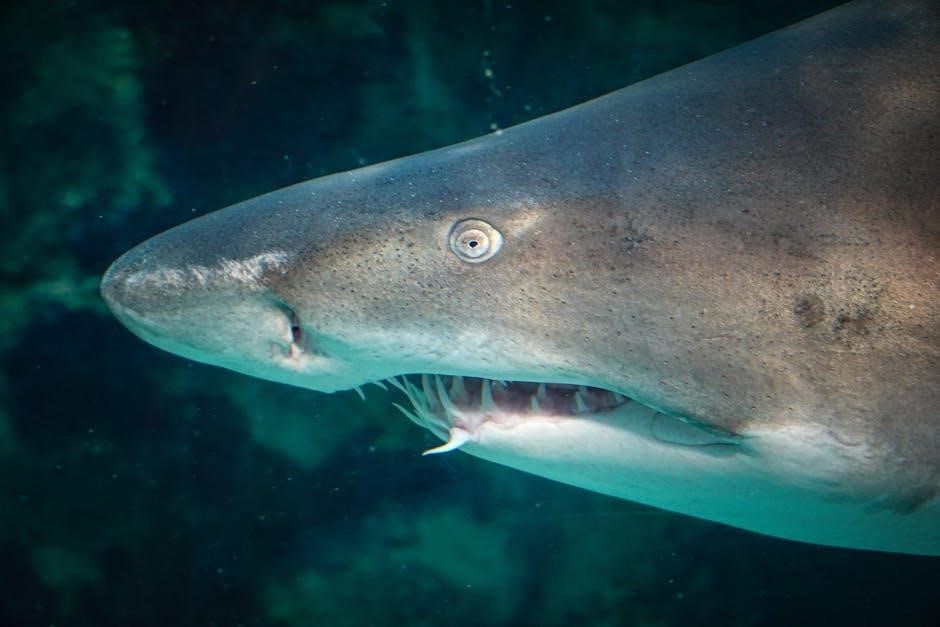
Shark teeth are fascinating fossils, shed by sharks throughout their lives, with some species losing up to 35,000 teeth․ They vary in shape, size, and color, making them popular for collection and study․ This guide explores their identification, types, and collection tips, helping enthusiasts uncover the secrets of these ancient dental remnants․

Overview of Shark Tooth Fossils
Shark tooth fossils are remnants of sharks’ teeth that have been preserved over millions of years․ These fossils provide valuable insights into the evolution and diversity of shark species․ Sharks continually shed their teeth, with some shedding up to 35,000 in a lifetime, making their teeth among the most common fossils found․ The fossilization process involves the replacement of the original organic material with minerals, resulting in durable, stone-like structures․ Shark teeth fossils vary in size, shape, and color, depending on the species and environmental conditions․ They are often found in coastal areas, beaches, and phosphate mines, where sedimentary layers preserve them․ Fossilized teeth are highly sought after by collectors and researchers, as they reveal dietary habits, predator behavior, and ecological roles of ancient sharks․ Their study also aids in understanding the geological history of marine ecosystems․ Shark tooth fossils remain a captivating subject for both scientific inquiry and hobbyist exploration․

Shark Tooth Identification
Shark tooth identification involves analyzing shape, size, color, and serrations․ Comparing these features to known species traits helps determine the origin, distinguishing species like megalodon, great white, and tiger sharks accurately and efficiently․
Physical Characteristics for Identification
Shark teeth vary significantly in shape, size, color, and serrations, making these features key for identification․ Tooth shape often reflects the shark’s diet, with pointed teeth for predators and flattened ones for crushers․ Size ranges widely, from microscopic to over 7 inches for megalodon teeth․ Color can indicate age, with newer teeth appearing white and older, fossilized ones turning black or glossy․ Serrations, the serrated edges, differ in coarseness and pattern, helping distinguish species․ Symmetry is another factor, as some teeth, like tiger sharks’, are deeply curved, while others, like great whites, are more symmetrical․ The root structure, including thickness and texture, also aids in identification․ By examining these physical traits, enthusiasts can accurately classify shark teeth, whether they’re fossilized remnants or freshly shed․ These characteristics provide a foundation for understanding the diversity of shark teeth and their evolutionary significance․
Classification Key for Common Shark Teeth
A classification key for common shark teeth involves examining specific traits to identify species․ Start by noting tooth size, with megalodon teeth being the largest, often exceeding 7 inches, while great whites typically range from 1․5 to 2․5 inches․ Next, assess serrations: megalodons have fine serrations, while great whites and tiger sharks display coarser ones․ Symmetry is another clue; great whites are symmetrical, whereas tiger sharks often have curved, asymmetrical teeth․ Root thickness varies too, with megalodons having a prominent bourlette, a dark area near the root, which is absent in most modern species․ Additionally, tooth color and gloss can indicate age, with blackened teeth being fossils․ By systematically comparing these features to known species traits, collectors can accurately classify their finds․ This method ensures precise identification, even for rare or worn specimens, making it an essential tool for enthusiasts and researchers alike․

Types of Shark Teeth

Shark teeth vary widely in shape, size, and color, reflecting their species and dietary adaptations․ Symmetrical, serrated, or curved, each tooth type offers unique clues about its origin, helping enthusiasts identify and classify them accurately․
Megalodon Shark Teeth
Megalodon shark teeth are among the most sought-after fossils due to their massive size and historical significance․ These teeth belonged to the Otodus megalodon, a prehistoric shark that could reach up to 60 feet in length․ The teeth are triangular, symmetrical, and highly serrated, with a thick, sturdy structure․ One of their most distinctive features is the bourlette, a dark band of exposed dentine near the root, which is absent in many modern shark species․ Megalodon teeth can range from 3 to 7 inches in length, with some rare fossils exceeding this size․ Their serrations are finer compared to those of the great white shark, and their roots are robust, indicating their immense bite force․ These teeth often appear glossy and black due to fossilization, making them stand out as prized collectibles․ The study of Megalodon teeth provides valuable insights into the biology and evolution of this apex predator, making them a cornerstone of shark tooth identification and collection․
Great White Shark Teeth
Great white shark teeth are highly sought after by collectors due to their distinctive characteristics․ These teeth are triangular in shape and highly symmetrical, with coarse serrations along the blade․ While they resemble megalodon teeth in shape, they are significantly smaller, typically ranging from 1․5 to 2․5 inches in length․ The root of the tooth is thin and lacks the bourlette found in megalodon teeth․ Great white shark teeth are often found in fossil form, appearing glossy and black due to the fossilization process․ Their serrations are coarser compared to those of the megalodon, and the symmetry can vary slightly, with teeth from the back of the mouth being less symmetrical than those from the front․ These teeth are a popular find among beachcombers and collectors, offering insights into the biology and evolution of one of the ocean’s most iconic predators․
Tiger Shark Teeth

Tiger shark teeth are highly distinctive due to their unique shape and serrations․ Unlike other shark teeth, they often appear curved or notched, with a flat profile that helps identify their position in the shark’s mouth․ The serrations on these teeth are coarse and prominent, adding to their recognizable appearance․ Tiger shark teeth are typically shorter, with the blade and root being nearly equal in length․ They usually range from 1 to 2 inches in length, though some can be larger․ The flatness of the tooth also indicates its original position, with teeth from the back of the mouth being flatter than those from the front․ This adaptability in tooth shape reflects the tiger shark’s diverse diet, which includes a wide variety of prey․ Their teeth are also often mistaken for those of the extinct species Physogaleus aduncus, though differences in root thickness and serration fineness can help distinguish them․ Tiger shark teeth are a favorite among collectors for their striking appearance and historical significance․
Lemon Shark Teeth

Lemon shark teeth are easily identifiable due to their unique curved shape, which often appears to form a 90-degree angle at the blade-root junction․ While they may seem symmetrical at first glance, closer inspection reveals a distinct curve․ These teeth are typically small, averaging around 0․75 inches in length, and are flat and narrow with no serrations․ The lack of serrations sets them apart from other species like the bull shark․ The lemon shark’s diet, which consists mainly of fish and crustaceans, influences the shape and function of its teeth․ Their teeth are designed for catching and holding prey rather than tearing or crushing․ Despite their small size, lemon shark teeth are notable for their sharpness and distinct curvature․ Collectors often find them appealing due to their unique shape and the challenge of distinguishing them from similar species like the bull shark․ Their flat profile and lack of serrations make them a standout in any collection․

Bull Shark Teeth

Bull shark teeth are characterized by their broad, flat shape and distinctive serrations․ One of the most notable features of bull shark teeth is their tapered serrations, which are coarse near the root and become finer towards the blade’s tip․ This unique serration pattern helps differentiate them from other species․ The teeth are also slightly curved, with a blade that meets the root at a sharp angle, creating a triangular appearance․ Bull shark teeth are generally small, averaging around 1 inch in length, though some may be smaller․ Their broad roots and robust structure make them durable, which is essential for their diet of hard-shelled prey like turtles and crustaceans․ The serrations also aid in gripping and tearing flesh, making them well-suited for the bull shark’s aggressive feeding behavior․ Collectors often find bull shark teeth appealing due to their distinctive shape and serration pattern, which sets them apart from other species like the lemon shark․ Their combination of functionality and unique morphology makes them a sought-after find among fossil enthusiasts․

Nurse Shark Teeth
Nurse shark teeth are small, flat, and uniquely designed for crushing, reflecting their diet of crustaceans and hard-shelled prey․ Unlike other sharks, nurse sharks have teeth that lack serrations, featuring a smooth, broad blade that meets the root at a sharp angle․ This distinctive shape allows them to grind and pulverize shells and exoskeletons effectively․ The teeth are typically small, averaging around 0․75 inches in length, and are often mistaken for those of other species due to their lack of prominent features․ Nurse shark teeth are also relatively rare in fossil form compared to more common species like the great white or megalodon․ Their small size and specialized function make them less striking but equally fascinating to collectors․ The flat, rounded shape of nurse shark teeth is a testament to their adaptation for a unique ecological niche, making them a valuable find for those interested in the diversity of shark dentition․